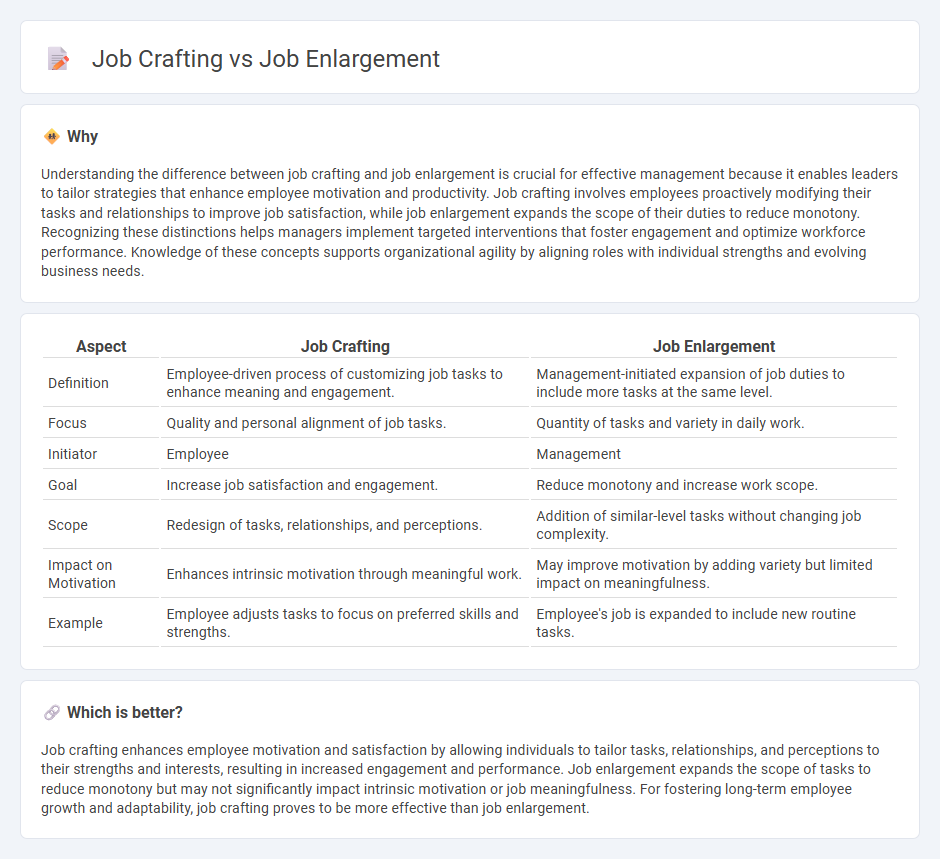
Job crafting empowers employees to redesign their own roles, enhancing job satisfaction and performance by aligning tasks with personal strengths and interests. Job enlargement involves increasing the number and variety of tasks within a job to reduce monotony and improve motivation without changing job level or responsibilities. Explore how these approaches differ in boosting workplace engagement and productivity.
Why it is important
Understanding the difference between job crafting and job enlargement is crucial for effective management because it enables leaders to tailor strategies that enhance employee motivation and productivity. Job crafting involves employees proactively modifying their tasks and relationships to improve job satisfaction, while job enlargement expands the scope of their duties to reduce monotony. Recognizing these distinctions helps managers implement targeted interventions that foster engagement and optimize workforce performance. Knowledge of these concepts supports organizational agility by aligning roles with individual strengths and evolving business needs.
Comparison Table
| Aspect | Job Crafting | Job Enlargement |
|---|---|---|
| Definition | Employee-driven process of customizing job tasks to enhance meaning and engagement. | Management-initiated expansion of job duties to include more tasks at the same level. |
| Focus | Quality and personal alignment of job tasks. | Quantity of tasks and variety in daily work. |
| Initiator | Employee | Management |
| Goal | Increase job satisfaction and engagement. | Reduce monotony and increase work scope. |
| Scope | Redesign of tasks, relationships, and perceptions. | Addition of similar-level tasks without changing job complexity. |
| Impact on Motivation | Enhances intrinsic motivation through meaningful work. | May improve motivation by adding variety but limited impact on meaningfulness. |
| Example | Employee adjusts tasks to focus on preferred skills and strengths. | Employee's job is expanded to include new routine tasks. |
Which is better?
Job crafting enhances employee motivation and satisfaction by allowing individuals to tailor tasks, relationships, and perceptions to their strengths and interests, resulting in increased engagement and performance. Job enlargement expands the scope of tasks to reduce monotony but may not significantly impact intrinsic motivation or job meaningfulness. For fostering long-term employee growth and adaptability, job crafting proves to be more effective than job enlargement.
Connection
Job crafting and job enlargement both enhance employee engagement by reshaping job roles to better fit individual skills and interests, leading to increased motivation and productivity. Job crafting allows employees to customize tasks and relationships within their existing roles, while job enlargement expands the scope of their responsibilities by adding similar tasks. Together, these approaches promote job satisfaction and organizational efficiency by aligning job design with employee strengths and career goals.
Key Terms
Task variety
Job enlargement increases task variety by adding more duties of a similar level to an employee's existing job, promoting skill diversification without altering the job's core nature. Job crafting allows employees to actively reshape their tasks, relationships, and perceptions, creating personalized task variety that aligns with their strengths and interests. Explore detailed strategies to effectively implement job enlargement and job crafting for enhanced employee engagement and productivity.
Employee autonomy
Job enlargement enhances employee autonomy by expanding the range of tasks performed, allowing individuals to take on more responsibilities and reduce monotony. Job crafting empowers employees to proactively modify their tasks, relationships, or perceptions to better align with their strengths and interests, fostering deeper engagement and control over their work. Explore the differences in how each approach boosts autonomy and impacts job satisfaction.
Role redesign
Job enlargement involves expanding an employee's range of tasks to increase variety and reduce monotony without altering the job's core purpose, enhancing role breadth. In contrast, job crafting empowers employees to proactively reshape their tasks, relationships, and perceptions of their roles, fostering deeper engagement and personalized job satisfaction. Explore how these role redesign strategies can optimize workplace productivity and employee motivation.
Source and External Links
What Is Job Enlargement? Definition, Benefits and Examples - Simpplr - Job enlargement is the process of increasing the number of tasks an employee performs within their current role, aiming to diversify their daily responsibilities and boost engagement by adding tasks at a similar skill level, such as a nurse taking on both patient care and discharge coordination.
What Is Job Enlargement? Meaning, Benefits and Examples - Indeed - Job enlargement, also known as job expansion, involves assigning employees more tasks within their existing position--typically at the same complexity--to enhance their skills, efficiency, and versatility, as seen when an assembly line worker starts assembling more parts of the product.
Job enlargement - Wikipedia - Job enlargement increases the scope of a job by adding duties at the same organizational level, which counters the monotony of specialization and division of labor, and often requires additional training so employees can handle the expanded role.
 dowidth.com
dowidth.com